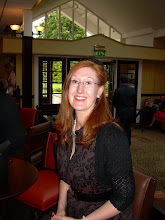 Saw The Edge of Love over the weekend (seemed appropriate as I was in Wales). It’s billed as “the first film about Dylan Thomas’s life”, but really it’s not so much about Thomas as about the two women in his life; his wife, Caitlin, played by Sienna Miller, and his childhood sweetheart, Vera (Keira Knightley). In fact Thomas (Matthew Rhys) seems a remarkably unattractive character – there are flashes of humanity – when he gets beaten up for “not being a hero” (ie not fighting in the war – he had weak lungs) – but generally, he seems flabby, child-like, self-indulgent, and entirely undeserving of two beautiful and independent women. How true to the real Thomas this is I don’t know, but as ever, it seems that being a great poet doesn’t make you a likeable – or even particularly interesting – person.
Saw The Edge of Love over the weekend (seemed appropriate as I was in Wales). It’s billed as “the first film about Dylan Thomas’s life”, but really it’s not so much about Thomas as about the two women in his life; his wife, Caitlin, played by Sienna Miller, and his childhood sweetheart, Vera (Keira Knightley). In fact Thomas (Matthew Rhys) seems a remarkably unattractive character – there are flashes of humanity – when he gets beaten up for “not being a hero” (ie not fighting in the war – he had weak lungs) – but generally, he seems flabby, child-like, self-indulgent, and entirely undeserving of two beautiful and independent women. How true to the real Thomas this is I don’t know, but as ever, it seems that being a great poet doesn’t make you a likeable – or even particularly interesting – person.The relationships in the film are fascinating, though. Thomas clearly wants to have his cake and eat it; the women don’t just put up with this but instead form a friendship that seems to transcend the usual petty boundaries of love, rivalry and jealousy. The war (the film is set in London during the Second World War) is seen mostly as bombs, soldiers and a brief bit of fighting when Vera’s husband is in Greece, but the real war is at home, as relationship battles are fought and not won but truces are called. It’s not a particularly active film, though – you do leave the cinema wondering what, exactly, happened...
Actually in tone – poetry read over scenes, gloomy passages when no-one speaks, ‘artistic’ layered images – the film reminds me of Sylvia, the film of Plath’s disintegrating relationship with Ted Hughes. There are, it seems, no happy endings for anyone involved with a poet. I’m still not sure whether or not I actually enjoyed The Edge of Love, but I’m glad I saw it – like Sylvia, it’s a film that will stay with me. Unlike Sylvia, though, it hasn’t particularly made me want to return to Thomas’s poetry.















